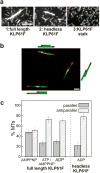The homotetrameric kinesin-5 KLP61F preferentially crosslinks microtubules into antiparallel orientations
- PMID: 19062285
- PMCID: PMC2657206
- DOI: 10.1016/j.cub.2008.10.026
The homotetrameric kinesin-5 KLP61F preferentially crosslinks microtubules into antiparallel orientations
Abstract
The segregation of genetic material during mitosis is coordinated by the mitotic spindle, whose action depends upon the polarity patterns of its microtubules (MTs). Homotetrameric mitotic kinesin-5 motors can crosslink and slide adjacent spindle MTs, but it is unknown whether they or other motors contribute to establishing these MT polarity patterns. Here, we explored whether the Drosophila embryo kinesin-5 KLP61F, which plausibly crosslinks both parallel and antiparallel MTs, displays a preference for parallel or antiparallel MT orientation. In motility assays, KLP61F was observed to crosslink and slide adjacent MTs, as predicted. Remarkably, KLP61F displayed a 3-fold higher preference for crosslinking MTs in the antiparallel orientation. This polarity preference was observed in the presence of ADP or ATP plus AMPPNP, but not AMPPNP alone, which induces instantaneous rigor binding. Also, a purified motorless tetramer containing the C-terminal tail domains displayed an antiparallel orientation preference, confirming that motor activity is not required. The results suggest that, during morphogenesis of the Drosophila embryo mitotic spindle, KLP61F's crosslinking and sliding activities could facilitate the gradual accumulation of KLP61F within antiparallel interpolar MTs at the equator, where the motor could generate force to drive poleward flux and pole-pole separation.
Figures


Similar articles
-
Kinesin-5 in Drosophila embryo mitosis: sliding filament or spindle matrix mechanism?Cell Motil Cytoskeleton. 2009 Aug;66(8):500-8. doi: 10.1002/cm.20349. Cell Motil Cytoskeleton. 2009. PMID: 19291760 Free PMC article.
-
A homotetrameric kinesin-5, KLP61F, bundles microtubules and antagonizes Ncd in motility assays.Curr Biol. 2006 Dec 5;16(23):2293-302. doi: 10.1016/j.cub.2006.09.064. Curr Biol. 2006. PMID: 17141610
-
The bipolar kinesin, KLP61F, cross-links microtubules within interpolar microtubule bundles of Drosophila embryonic mitotic spindles.J Cell Biol. 1999 Jan 11;144(1):125-38. doi: 10.1083/jcb.144.1.125. J Cell Biol. 1999. PMID: 9885249 Free PMC article.
-
Mitotic motors and chromosome segregation: the mechanism of anaphase B.Biochem Soc Trans. 2011 Oct;39(5):1149-53. doi: 10.1042/BST0391149. Biochem Soc Trans. 2011. PMID: 21936780 Review.
-
Emerging Insights into the Function of Kinesin-8 Proteins in Microtubule Length Regulation.Biomolecules. 2018 Dec 20;9(1):1. doi: 10.3390/biom9010001. Biomolecules. 2018. PMID: 30577528 Free PMC article. Review.
Cited by
-
Tum/RacGAP functions as a switch activating the Pav/kinesin-6 motor.Nat Commun. 2016 Apr 19;7:11182. doi: 10.1038/ncomms11182. Nat Commun. 2016. PMID: 27091402 Free PMC article.
-
Determinant factors for residence time of kinesin motors at microtubule ends.J Biol Phys. 2023 Mar;49(1):77-93. doi: 10.1007/s10867-022-09623-x. Epub 2023 Jan 16. J Biol Phys. 2023. PMID: 36645568 Free PMC article.
-
Kinesins in Mammalian Spermatogenesis and Germ Cell Transport.Front Cell Dev Biol. 2022 Apr 25;10:837542. doi: 10.3389/fcell.2022.837542. eCollection 2022. Front Cell Dev Biol. 2022. PMID: 35547823 Free PMC article. Review.
-
Kinesin-5/Cut7 C-terminal tail phosphorylation is essential for microtubule sliding force and bipolar mitotic spindle assembly.Curr Biol. 2024 Oct 21;34(20):4781-4793.e6. doi: 10.1016/j.cub.2024.08.035. Epub 2024 Oct 15. Curr Biol. 2024. PMID: 39413787
-
Determinants of Polar versus Nematic Organization in Networks of Dynamic Microtubules and Mitotic Motors.Cell. 2018 Oct 18;175(3):796-808.e14. doi: 10.1016/j.cell.2018.09.029. Cell. 2018. PMID: 30340043 Free PMC article.
References
-
- Brust-Mascher I, Scholey JM. Mitotic spindle dynamics in Drosophila. Int Rev Cytol. 2007;259:139–172. - PubMed
-
- Walczak CE, Heald R. Mechanisms of mitotic spindle assembly and function. Int Rev Cytol. 2008;265:111–158. - PubMed
-
- Kapitein LC, Peterman EJ, Kwok BH, Kim JH, Kapoor TM, Schmidt CF. The bipolar mitotic kinesin Eg5 moves on both microtubules that it crosslinks. Nature. 2005;435:114–118. - PubMed
Publication types
MeSH terms
Substances
Grants and funding
LinkOut - more resources
Full Text Sources
Molecular Biology Databases

